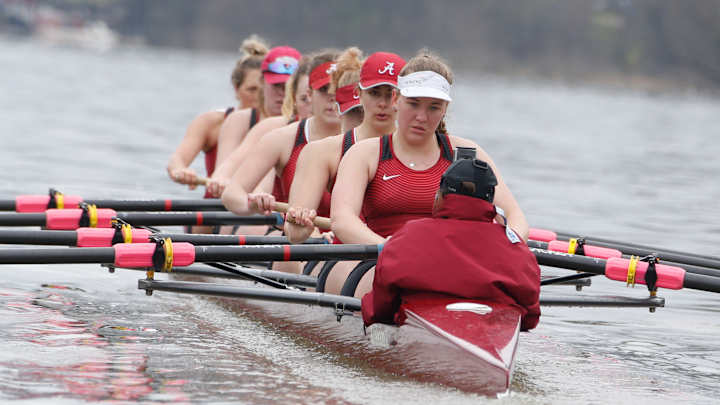Alabama Rowing Beginning to find its Rhythm

Which one of the following is true of the Alabama rowing program?
• It’s coming off its most successful season to date.
• It has the biggest roster of all the Crimson Tide women’s sports, with 20 scholarships.
• The person running it was the Big 12 Coach of the Year in 2019.
Actually, all of those are true.
During his first season guiding Alabama, which does compete in the Big 12, Glenn Putyrae established a new standard for the program.
It was ranked nationally, swept a top-20 team in a head-to-head matchup and had an athlete named an All-American.
All were program firsts.
He considered a good starting point.
“Oh, I’m never satisfied,” Putyrae said. “I think the athletes would admit that by the end of the season there were things that we could have done better. And there were things that we learned.
“We started hot. We had really good performances early on. We hit a little bit of a plateau, I don’t want to say complacency, but we had a little bit of a point where we started taking things for granted. We started looking ahead.”
That’s quite a contrast to how the program and sport used to be regarded.
While rowing may be the oldest intercollegiate sport in the United States, it's never been a prominent one in the region. Overall, there are 88 Division I programs that have women’s teams, dominated by the tradition-rich school on the east coast. The Ivy League schools are especially known for rowing, with the Head of the Charles in Boston a huge event, and boat houses lining the river at the Schuylkill River in Philadelphia, the home of the Dad Vail Regatta.
West coast programs like Stanford and Cal have made tremendous progress, and the most successful in the extended south have been Duke and Texas. In between, Tennessee set the standard among the schools that make up the Southeastern Conference in most other sports. Because there aren’t enough teams for it be considered a league sport.
Previous to 2005, rowing didn’t exist at Alabama either except as a club, and had the facilities to match. Under the direction of Larry Davis, who oversaw the transition to Division I, the team started competing in the fall of 2006. A state-of-the-art, 11,463 square-foot boathouse opened in the fall of 2014.
That all got the program going. Now under Greg Byrne it’s become a priority, an investment that’s beginning to pay off. Moreover, last year’s success is beginning to make waves on campus.
“Rowing’s not one of those sports that’s typically seen as being a revenue sport,” Putyrae said. “To see the administration, and support staff, and the athletic director take an interest …
“Everyone talks about how nice it is to see Sarah Patterson come down to the race course to watch a race, and she says hello. These are little things that give you a sense of what you’re doing is valued. That’s huge for the athletes and it certainly impresses coaches.”
With that in mind, consider some of the following barometers:
Last year, Alabama finished second at the Big 12 Championships, and the coach-of-the-year honor was the program’s first.
Putyrae came to Tuscaloosa with 19 years of head coaching experience, including 15 with two programs, Gonzaga (1999-2007, 2011-18) and Georgetown (2007-11). He took the Zags to five WCC championships between 2013-18, the first of which landed the programs first bid into the NCAA championships (they finished 19). Despite having just five scholarships, which is 15 less than the maximum allowed by the NCAA, Gonzaga finished in the top 20 in each national meet.
Alabama not only had its first All-American, but it was someone who was developed in the program.
During her first full year in the sport at Alabama, Jorja Macrae earned the honor from the Collegiate Rowing Coaches Association (CRCA). The Whataroa, New Zealand native rowed with Alabama’s First Varsity 8+ and led the Crimson Tide to its first national ranking during the season.
“We did a lot of work the summer before she came back, between her first semester and first full year.” Putyrae said. “She just trained a lot, and kind of re-invented herself.
“She was willing to work hard and started to see some success. She kind of got excited about that and wanted more success.”
More are on the way. As of this writing there were 78 names listed on the Crimson Tide roster. It’s the biggest group of athletes in any Alabama sport minus football and trac and field collectively (there’s 50 women on the track team, and 38 on the swimming and diving team).
You look at the lineup for a big weekend event, and the word armada comes to mind.
Regardless, there’s a lot in the works, which brings us back to Putyrae not being satisfied.
Last year his coaching staff, which didn’t know what to expect, set the initial goal of finishing in the top three of the conference. After Alabama’s first major race in the fall it was already clear they had been a little too conservative.
“It’s hard to change gears mid-year,” he said. “We tried, but I don’t think we were successful. It wasn’t from lack of effort. Nobody didn’t do but their best at the end of the season. But part of it is learning how to do it.”
Nevertheless, the Crimson Tide started to have a national presence. Publications that follow the sport started to write stories about the growing power in the south, and even the most veteran coaches took notice. Alabama may have been a non-traditional player in the sport, but it was showing up on everyone’s radars.
“It’s harder to get on it than to stay,” Putyrae said. Ultimately, results are going to do all the talking.”
Thus the goals for this season: Build on what was established last year and continue to grow and prosper. Don’t shift gears.
Alabama certainly didn’t during its successful fall schedule.
“I think this year’s seniors are going to be motivated to be better than what we were last year,” the coach said. “They want to make the NCAA championships, which hasn’t been done.
“There are still a lot of things that haven’t been done before.”
This is the first story in a "What's Next" series on Alabama's winter and spring sports that will appear on BamaCentral this week.
